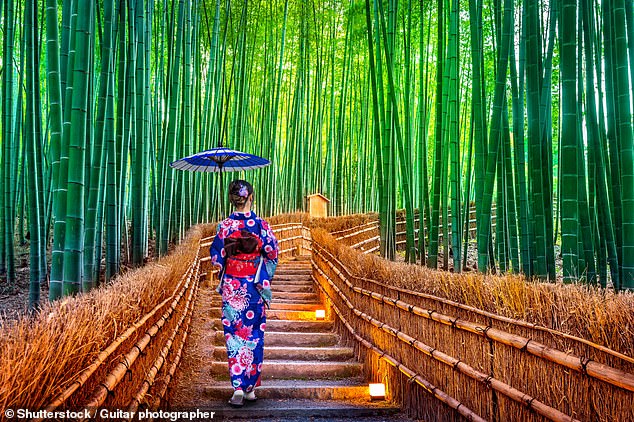Japan at its most divine: these 10 heavenly gardens are sanctuaries of nature – and will soar your spirits

They say that only four in ten tourists to Japan ever see the most sacred landscape – a view of Mount Fuji – because it is so often lost in mist and clouds.
Unpredictable weather is something that Britain and Japan have in common, along with a tendency to queue respectfully. But on my tour of Japan’s most beautiful gardens, brilliantly organised by Riviera travelsit was the differences between our cultures that proved most intriguing.
After all, no one goes to the Land of the Rising Sun for the beaches – although I believe there are plenty to see. Also, not many people make the 14-hour flight for the museums and galleries, although there are many of those too.
But people do go for the gardens, the cherry blossoms or the autumn colours – and they are never disappointed. Japanese gardens are not like British ones.
They are mostly gems of artifice, miniature landscapes and constructed vistas of hills and ponds, reinforced by strict disciplines and traditions, many of which have remained unchanged for centuries.

Sculpted: A woman walks through the Sagano Bamboo Grove – ‘a mountainside bamboo grove whose amazing trees rise above the crowds’
They reflect the Japanese character – fierce attention to detail, driven by an obsessive perfectionism that, for example, requires all their ubiquitous Chinese pine trees to be pruned to within an inch of their pampered lives, with dead needles removed by hand every autumn. .
There are strolling gardens, designed for contemplative walking, with every corner designed to reveal a new scene. There are tea gardens, often with so-called ‘borrowed landscapes’, where elements outside the walls – a mountain or a castle – are included in the view. And then there are the Zen gardens, often courtyards of raked gravel, tended by Buddhist monks, where strategically placed rocks are placed for the purpose of meditation.
They reflect the Japanese character: a fierce attention to detail, driven by an obsessive perfectionism
They all subscribe to the Japanese Shinto belief in the sacredness of nature. It is said that there are many thousands of Shinto gods, embodied in rocks, water, air and the living beings of plants, trees and moss.
Our carefully managed tour took us with ruthless efficiency by train, bus and even ferry from Tokyo to Hiroshima and then on to Kyoto and Nara.
It took me a while to get used to joining a ‘crocodile’ of 40 people following a small guide waving a pompom. But what would have felt like a humiliation in, say, London, somehow seemed almost natural in obedient, respectful, ultra-polite and organized Japan – a country where 60 percent of lost wallets are returned to their owners untouched.
At the end of the trip, as I stood at a red light with no traffic in sight, I thought, “My goodness, I’m going to be Japanese.”
Here are ten gardens you shouldn’t miss.
Hotel New Otani, Tokyo
Odd to start with a hotel garden, except that the vast 1,000-room Tokyo landmark that has counted Bill Clinton among its guests is 400 years younger than the ancient Shogunate gardens that surround it. This astonishing two-hectare stretch of ponds, waterfalls and traditional tearooms in the heart of the capital is an oasis of calm, despite its towering neighbours.
Details: Free admission. Open daily from 6am to 10pm (newotani.co.jp).
Okayama Korakuen

A tea house in Okayama Korakuen, shown, a garden with ‘elegant avenues and tea houses’ and a wide lawn
This large walking garden was completed in 1700 by a local aristocrat. Situated on its own island, it includes unusual rice paddies and an aviary of cranes – the sacred bird and harbinger of longevity. In addition to elegant avenues and teahouses, the garden includes extensive lawns.
Details: Admission €2.50. Open daily from 7:30 am to 6:00 pm, March to September (okeama-korakuen.jp).
Murin-an, Modern Garden, Kyoto
Just over a mile from the epicenter of the atomic bomb explosion, this jewel of Hiroshima, the Shukkeien Garden, has been restored to its former glory
A small but delightful water garden with man-made streams that wouldn’t look out of place in Scotland if they weren’t carefully managed and cleaned weekly. Trees are pruned to incorporate the ‘borrowed’ views of distant forested mountains.
Details: Admission €4.50. Open daily from 9am to 6pm (murin-an.jp).
Hamarikyu Gardens, Tokyo
These riverside “walking” gardens were once the private domain of the Tokugawa Shogunate. Elegant winding paths highlight micro-managed trees, including miniature Scots pines, each needle removed by hand as it turns brown and dies.
Details: Adults £1.50, children free. Open daily from 9am to 5pm (tokyo-park.or.jp).
Hakone Wetland Botanical Garden
An extremely unusual wetland garden of swamp, peat bog and marsh in fashionable Kanagawa Prefecture. The wildly varied terrains are home to rabbit ear irises, swamp primroses, mountain peonies, dogwoods and countless alpine highland plants.
Details: Adults £3.50, children £2. Open daily 9am-5pm, March-November (hakone-shisseikaen.com).
Imperial Palace Gardens, Tokyo
The closest thing to a park as we know it is the East Garden of the Imperial Palace, another sanctuary. Entering over a moat, through magnificent walls and gatehouses, the wide paths and tall trees provide promenades that you might find in Hyde Park.
Details: Free admission. Open Monday to Friday, 9am to 6pm in summer, 9am to 4pm in winter (kunaicho.go.jp).
Shukkeien Garden, Hiroshima
Just over a mile from the epicenter of the atomic bomb explosion, this jewel of Hiroshima has been restored to its former glory. A large pond, crossed by a symbolic bridge, is surrounded by carefully constructed viewpoints, each highlighting choreographed vistas of bamboo forests, tea plantations, peony and plum orchards, and man-made islands. Two Gingko trees are identified as survivors of the terrible fire.
Details: Adult £1.30, children 50p. Open daily 9am-6pm in summer, 9am-5pm in winter (shukkeien.jp).

The Meiji Shrine in Tokyo (above) is ‘not so much a garden as a man-made forest of 60,000 trees’
Meiji Shrine, Tokyo
It’s less a garden and more a man-made forest with 60,000 trees, planted to hide a beautiful shrine celebrating the Meiji Restoration.
It is the moment during our Victorian era when the old shogunate handed the task of modernizing long-isolated Japan back to the emperor and to a parliamentary democracy modeled on our own.
Details: Free admission. Open daily (meiijingu.or.jp).
Sagano Bamboo Forest, Kyoto
Hidden behind the 600-year-old Zen Buddhist Tenryu-ji Shrine, a UN World Heritage Site, lies a bamboo forest on the mountainside, its impressive trees towering above the crowd.
Details: Free admission. Open daily, 24 hours a day (yes.kyoto.travel).
Ryoan-ji Temple Garden, Kyoto
It is Japan’s most famous Zen garden, and its centerpiece is a gravel courtyard in which 15 large rocks are strategically placed for contemplation. Legend has it that if you can see all 15 rocks at once, you have achieved enlightenment.
Details: Adults £3, children £1.50. Open daily from 8am to 5pm in summer, from 8.30am to 4.30pm in winter (www.ryoanji.jp).




